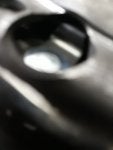I noticed some brake fluid under my clutch pedal, it was coming from where the brake fluid reservoir's line goes into the clutch master cylinder. I cannot engage any gear when i start up the engine. Pumping the clutch pedal has no effect. With the engine off, i can go through every gear quite easily. I also noticed a creaking noise when depressing the pedal, it sounds like its coming from under the car/inside the transmission. Is the clutch master cylinder responsible for all of this? Appreciate any help.
(Gearbox model: 717460 )
(Gearbox model: 717460 )





